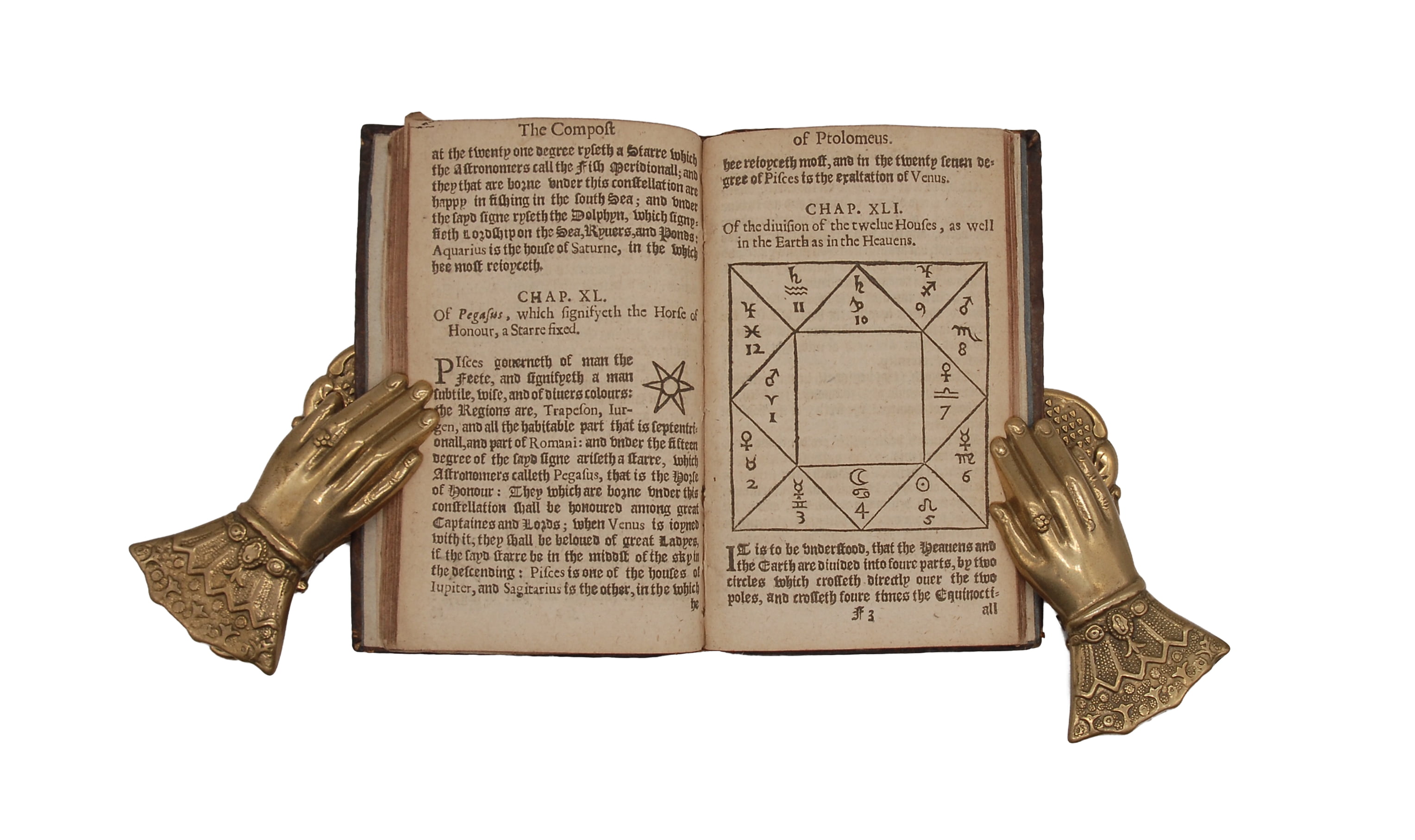PTOLEMY, Claudius
AMERICANUM
The Compost of Ptolomeus, Prince of Astronomie. Very necessary and profitable for all such as desire the knowledge of the famous art of astronomie.
London, By M. P[arsons] for Henry Gosson, and are [to be sold by Edward Wright, 1638[?]£19,500.00
4to. 72 unnumbered leaves. A-I . Black letter some Roman. Large astronomical woodcut of ‘K. Ptholomeus’ and an astronomer (just chipped at fore-edge) on title, woodcut and typographical headpieces, small floriated initials, sixty three woodcuts in the text, including a figure of the heavens, the 12 signs of the zodiac, a world map, physiognomoligcal portraits, a large woodcut of a dragon in landscape on verso of last, chiromantic hands, and stars etc, monogram ‘H. R.’ with shelf mark on fly. Light general age browning, heavier in places, title slightly dusty, light waterstaining on first few leaves, occasional mark or stain. A good copy in English calf circa 1800, covers bordered with a single gilt rule, spine gilt ruled, title gilt lettered, a.e.r. a little rubbed.
Exceptionally rare edition of this popular astronomical text, very charmingly illustrated with numerous woodcuts, the last of the early editions, the only edition printed in the seventeenth century. The rather rudimentary map is marked i.a. with Mexico, New England, the West indies, Peru, the Straits of Magelan, Brasil and Virginia. Below the two southmost capes is a the land mass described as the ‘South Continent’. The work was originally translated from the French ‘Compost et kalendrier des bergiers’, and appeared in two forms throughout the C16th; one as ‘The Kalender of Shepards’ and the other with the title ‘The Compost of Ptholomeus’. Although they are often described as containing nothing from Ptolemy, other than the falsification of authorial attribution, the work does have a general articulation of some of the astrological matters set forth in Ptolemy’s Quadripartitum. The influence of astronomy over individuals is discussed, and this version has a chapter on palmistry added at the end. “In the ‘Kalendar of Shepherds’, the putative source of the astrological and health information is initially an unnamed, ancient shepherd. … the authentication for the information in the text was a natural and pastoral figure of wisdom, the void of book learning. In the prologue, it is also stated that ‘this boke was made for them that be no Clerkes to brynge them to great understandynge’ thus identifying itself as a text for a non-elite readership yet at the same time offering access to the very traditional classical learning skills and intimating a connection between the occult knowledge and active reading. .. In Notary’s 1506 edition, Ptolemy is merely cited in the table of contents in relation to the twelve signs of the zodiac but not mentioned in the text. In Pynson’s 1518 edition, Ptolemy is referenced both textually and visually, again in relation to the zodiac, but as a very minor reference in the text. .. Beginning in the 1530s, the strand of the multi-text breaks off; the text is condensed, new images are added, others are eliminated, and the title is changed to the ‘Compost of Ptolomeus, Prince of Astronomy’ .. These editions, initially published by Robert Wyer, make a significant modification: the name of the Ptolemy is increasingly inserted into the verbal text, shifting the authentication from the ancient shepherd to Ptolemy. .. The Catholic feast day calendar is eliminated, along with much of the Christian moralising and, generally, a narrower focus on the astrological components. Neither the woodblock image of the shepherd nor that of the scholar carries over once the text is renamed ‘The compost of Ptolomeus;’ instead, the symbolic function previously vested in the figure of the scholar shepherd is now conflated into the single figure of Claudius Ptolomy, ‘Prince of Astronomeye’. ..In his editions of the Compost, Wyer not only strengthened the association of the verbal and visual text with Ptolemy, but also incorporated specifically geographical information; Wyer appends a ‘Rutter’, a navigational chart of the distances between various port cities, consequently increasing the function of the text as a source of geographic information.. For English readers in the early print era the images of and attribution to Ptolemy thus narrate and mediate an encounter with emerging geographical thought. The textual and visual attribution to Ptolemy created a kind of aura for the text that mystified the diffuse authorship of the work, and that subsumed the fascination with the occult and Catholic ritual into a pseudo-scientific discourse.” Keith D. Lilley ‘Mapping Medieval Geographies: Geographical Encounters in the Latin West’.
Unsurprisingly all editions of this ephemeral and popular work it are exceptionally rare; ESTC records no more than two copies of any of the five earlier editions of this text, and records this, the only seventeenth century edition, in three copies only, two at the BL and one at Birmingham University library. No copies recorded in the US.
ESTC S112005. STC 20482. Not in Cantamessa.In stock




















